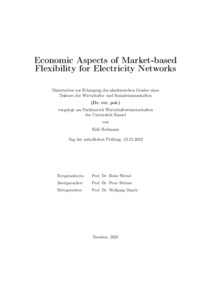| dc.date.accessioned | 2023-01-19T10:46:16Z | |
| dc.date.issued | 2023 | |
| dc.identifier | doi:10.17170/kobra-202212127216 | |
| dc.identifier.uri | http://hdl.handle.net/123456789/14376 | |
| dc.language.iso | eng | |
| dc.relation.haspart | doi:10.1016/j.jup.2020.101133 | |
| dc.relation.haspart | doi:10.1016/46j.segy.2021.100055 | |
| dc.rights | Urheberrechtlich geschützt | |
| dc.rights.uri | https://rightsstatements.org/page/InC/1.0/ | |
| dc.subject.ddc | 330 | |
| dc.title | Economic Aspects of Market-based Flexibility for Electricity Networks | eng |
| dc.type | Dissertation | |
| dcterms.abstract | This thesis contributes to the discussion of the utilization of network-supportive flexibility, in particular in the context of local flexibility markets (LFM). The thesis comprises five articles that are methodologically related but can be read independently. The focus of the investigations is on economic aspects and short- and medium-term market processes.
Chapter 1 provides an introduction to the topic including the definition of the most important terms. Chapter 2 includes the paper, “Design of regional flexibility markets for electricity: A product classification framework for and application to German pilot projects,” which constitutes a comprehensible discussion of flexibility product design that combines technical requirements and classical auction theory. A product design framework is provided and applied to five LFM approaches used in German research projects. In Chapter 3, the paper “Matching supply and demand of electricity networksupportive flexibility: A case study with three comprehensible matching algorithms” is presented. Here the problem of matching supply and demand is discussed in the context of an abstracted LFM model. Based on this discussion, three different matching approaches are introduced and demonstrated in a case study.
In Chapter 4, the paper “Machine learning in energy forecasts with an application to high frequency electricity consumption data” provides a methodological digression on the topic of energy forecasts based on machine learning approaches. Using a standardized model selection framework, three forecast model approaches of varying complexity are implemented and compared using two different input datasets. The study provides a general guideline for the application of forecast models.
The paper in Chapter 5, “The impact of transparency policies on local flexibility markets in electrical distribution networks: A case study with artificial neural network forecasts,” investigates the influence of market transparency on LFMs. Based on synthetic LFM market data forecast models for two forecast tasks – forecasting the network status and the LFM outcome – are implemented and tested. The reduction of the forecast models’ input data approximates different transparency policies. The results are interpreted to provide suggestions for the design of a general LFM transparency policy. In Chapter 6, the paper “Long-term Contracts for Network-supportive Flexibility in Local Flexibility Markets” complements the discussion on flexibility products by using the provided flexibility product framework to specify a capacity-based, longterm flexibility product. The suggested product design focuses especially on the utilization of DR flexibility in LFMs. Therefore, requirements of network operators as well as flexibility providers are reviewed and summarized in three targets for a functional flexibility product design.
The thesis finishes with a conclusion in Chapter 7. | eng |
| dcterms.accessRights | open access | |
| dcterms.creator | Heilmann, Erik | |
| dcterms.dateAccepted | 2022-11-23 | |
| dcterms.extent | xiv, 205 Seiten | |
| dc.contributor.corporatename | Kassel, Universität Kassel, Fachbereich Wirtschaftswissenschaften | ger |
| dc.contributor.referee | Wetzel, Heike (Prof. Dr.) | |
| dc.contributor.referee | Birkner, Peter (Prof. Dr.) | |
| dc.contributor.referee | Mauch, Wolfgang (Prof. Dr.) | |
| dc.subject.swd | Elektrizitätsmarkt | ger |
| dc.subject.swd | Energiepolitik | ger |
| dc.subject.swd | Maschinelles Lernen | ger |
| dc.subject.swd | Markttransparenz | ger |
| dc.type.version | publishedVersion | |
| ubks.embargo.terms | 2023-11-23 | |
| ubks.embargo.end | 2023-11-23 | |
| kup.iskup | false | |
| ubks.epflicht | true | |

